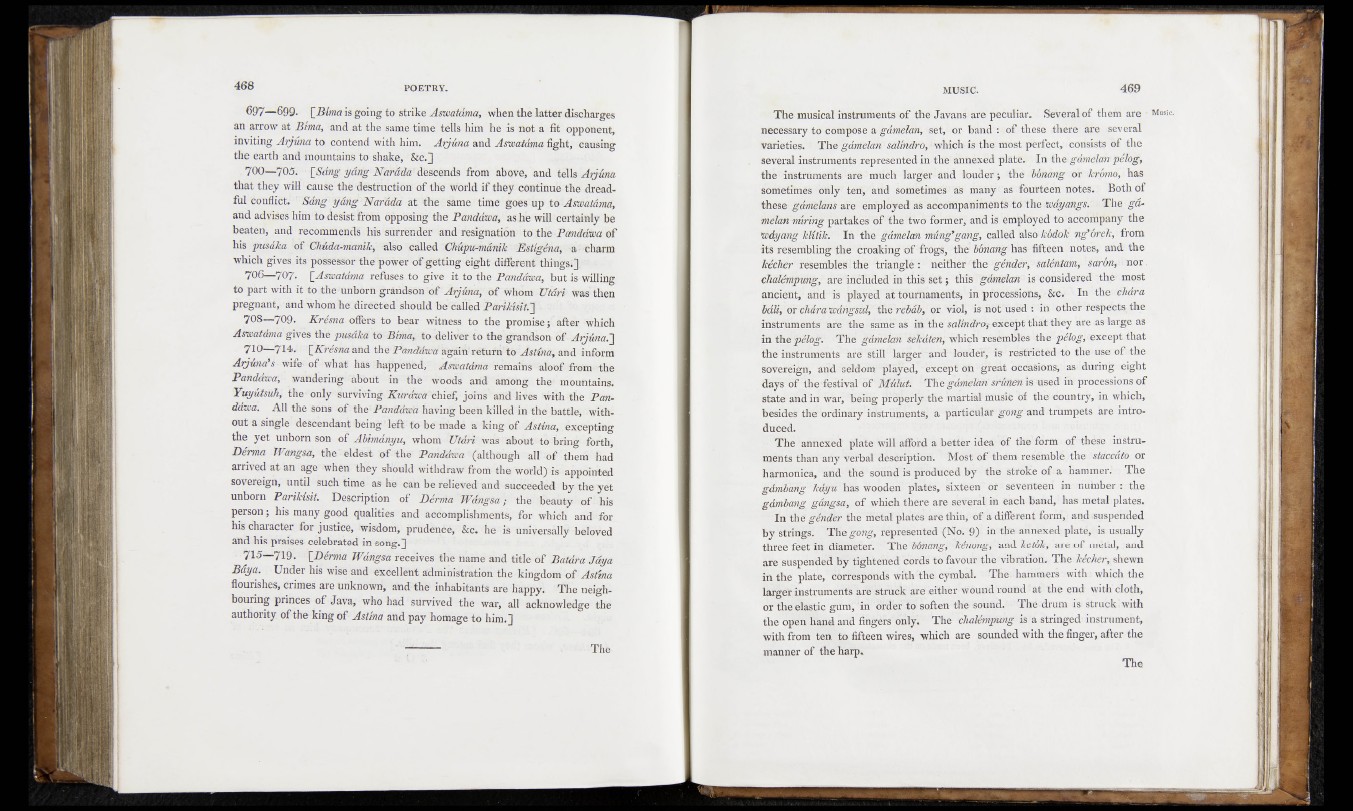
697—699. \_Bima is going to strike Aswatdma, when thé latter discharges
an arrow at Bima, and at the same time tells hijn he is not a fit opponent,
inviting Apuna to , contend with him. Arjuna and Aswatdma fight, causing
the earth and mountains to shake,' &c.J \
. 7OO—l705^ ‘ £Sdng yang'Ndrdda1 d'éScmds from above, and tells Arjdna
that they wilt cause the‘destruction1 of the world if they c0Utinue>the dread-
ful conflict.'r: Sdng yang •Nav&dé at the same time goes up t&Aswatdma,
and advises him’to desist feorn Opposing the Pancldwa, as .he will certainly be
beaten, and recommends his surrender and resignation to the -Pmddwa of
his pitëdka o f Gk&da-manik, also called Ghupu-m&nik Bstigéna, •» - charm
"which give£its possessor thé ^poWer "of getting eight’ different-things!].";
706—707» Ji[Aswatdma refnses-to give it to the Panddwa, but is willing
to part with it to.the'Unborh grtódsón o f Arjtiria, of whom TJtdirv was then
pregnant, and whom heüirëetfed Should herêaÖéd PanMsit.^ ■
708—709. JKrésna offers to bear witness, to the promise \ after which
Aswatdma gives thé puêdkd to Bma, to deliver-to the grandson- o f -Aiyéna.'^
710—714* ^Kréshawdd th&ParuMwrf ‘agalt^return to Astina, and inform
Arjüna s wife*'ofwhat has happerifed, Aswatdma -remains‘-'alooffr©m*~fche
Panddwa, wandering about in thé woods arid among the1 mountains*
Yuyulsuh, the • only' -solving Kurdwa-chief, joins and livës ’with -the Pan-
ddWa. A-ll the sons -of- thOPanddwki having beeh kï'Hédin the'battle^-without
a single" descendant ‘being ’ left to béihadè a'kingbfiAsléia, .excepting
the yet unborn son of Abimdnyu, whom Utdri was :about;-to4>ring-'forth,
Dérna WangSa, the-eldest of-the Panddwa "(although all n>tM|hei& Had
arrived at an age when they should withdraw from-the world^is- appointed
sovereign, until such time as ho can be rëlieYed^and'-succeeded ’ by* the yet
unborn Parikisit. Description oI DérmU "'Wdngsa thé' beatify--of' his
person; his many good qualities and accomplishments, for which andWor_
his character for justice, wisdom, prudence, &e* 'he-is universal^-beloved
and his praises celebrated in song.]
715—719P^B érm a Wdngsa receives the name and title;óf Batdfa-ïïdya
Mdya. Under his wire and éfcdelteüt administration the kingdom of- Asfma
flourishes, crimes are unknown, and-the inhabitants are happy* The neighbouring
princes of Java, who had survived the war, aft acknowledge the
authority, of thé king of- Astina and pay homage to him.]
The
The musical instruments of the* Javans are peculiar. Several of them are jj Music,
necessary to compose a ‘gamelan, set, or b‘and ':£of these there are several
varieties. * YhO-gdmelaH ‘ salindro, *-which- is - the most perfect, consists of the
several instruments represented in-'the5 annéxèd plate- -In ths-gamelan*pélog,
the instruments a-re^m'uéh larger and louden; the' bbnang or ^brcrnio, has
sometimes oftly ten, and sometimes- aS many' as -fourteen notes.- Both of
these gdmtlanS are employed as accoitipanimentMo'the way mgs. The gamelan
miring partakes óf^fhe iwo former; and is employed tö’accompany the
tèdyang TeUtik'. In* the gamelan •rri'dng’gdng, called also1 kb'dok- ng'órek, from
its resembling the croaking of-frogs, ;thë‘ bbnang has- fifteen -nbtes, and the
'keeker' resembles 1 the triariglé : -neiftièr't'ho^géndèrf salhdxm, ' sarbn^vriov
chalémpung, are'included in this s e t this 'gémelan-1 is considered the' most
ancient, and is pl’ayëÜ at toufnamerits, in pfocessions, - &C.1 In the chara
bdli, oY'chara'wdftgsul,' the rebab, or viol, is'ribfüséd : "in other fe'spécts_ the
instruments 'afe the same as ih the .vaZiwdra,-except that they are as large as
in the 'pêlo^.' The gdrhèlan 'sèkateni 'wttchf'résémblfes -thè-pélogi ('except .that
IftSe instruments hre5,1still' iafger-and‘-!oöfte¥,-is restricted -to the use of--the
sovereign, and seldoro'played, ' except oh^gie'al! occasions, as during eight
days d?'liie*fe'ltiV?al:of‘ Midut. The gdmèlèdi srunen Is'tfsed ih< processions of
state and in war, being properly the martial musifc of the' country, in which,
besides thériordinary instruments',' a particular gang rind trumpets are introduced.
The'annexed' plate will afford a better idea- of the form of these -instruments
than* any verbal description. s ’’Most of ^hém- resemble; the staccato or
harmonica,'and^ttïe sound is produced by the stroke of;a hammer: - The
gdïÈm g' My'u' has wooden' plates, sixteen or seventeen in nubaberthe
gdmbang gmgm% .(A which there are several in êach band, has metal.plates.
In the géndèr the ihetal plates are tbin,r óf a different form,; andtsuspeSded
by JThe gong, represented (No/9)^ ift-tfré .axinekèd. plate, is usually
three1 firet Iti dtdiheter. 'The bbnang, -kénong, arid ketbk, are of metal, and
are suspended by tighte&fedJ cords to Ïavóuï’thé Vibration.- The kéeker^shewn
in the plat’e, corresponds with the. cymhal. The--hammers with; which the.
larger instruments kre struck are either wóurid round ’ at the end with" cloth,
or the elastic gum, ’in ordfer-ttf soften the sound.'--' Tbê-'drum is- struck:with
the open hand and fingéfooniy, iThe -chalémpung is a stringed instrument;
with from ten to fifteen wires, which are sounded with the finger, after the
manner of the harp.
The